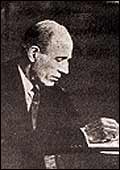|
1780:
India's first newspaper (weekly), the India Bengal Gazette is published
1818:
Dig Darshan, the first Indian language paper is published from
Calcutta
1822:
The Gujarati daily, Bombay Samachar, starts publication from
Mumbai; today; it is the oldest existing newspaper in Asia
1850:
The East India Company sanctions funds for a telegraph line
between Diamond Harbour and Calcutta
1855:
The Government of India grants a licence to the Oriental Telephone
Company, to establish exchanges at Bombay, Calcutta, Karachi, Madras,
and Rangoon
1882:
Undivided India's first telephone exchange is commissioned in
Bombay
1885:
Indian Telegraph Act enforced
1923:
The Radio club of Bombay starts broadcasting
 |
| Lord Irwin |
1927:
Lord Irwin inaugurates the Bombay station of Indian Broadcasting
Company
1935:
Akashvani Mysore, a private radio station, is born
1936:
Indian Broadcasting Company becomes All India Radio (AIR).
 |
| The AIR HQ |
1943:
The Indian Wireless Act is enacted; telephone services are nationalised
1947:
Press Trust of India (PTI) comes into being
1955:
A.D. Booth of Birbeck College, London, builds a computer, a
one kilobyte memory HEC-2M, for the Indian Statistical Institute
1957:
Vividh Bharati kicks off
1959:
Televison programmes are launched in India; the Tata Institute
of Fundamental Research Automatic Calculator (TIFRAC) is prototyped
1961:
ESSO installs first commercial computer, an IBM 1400 at Bombay
 |
| Big Blue: now in India |
1962:
Indian television's first soap opera-Teesra Rasta enthralls
viewers
1963:
IBM starts manufacturing computers in India
1967:
First commercials appears on Vividh Bharti
1976:
Television and AIR separate; Doordarshan comes into existence
1977:
AIR's Madras station launches country's first FM service
1978:
First television commercials seen; the minicomputer policy is
tabled
 |
| Asiad 82: coloured lenses |
1982:
To coincide with the Delhi Asian Games, Doordarshan begins colour
transmission
1984:
Hum Log, Doordarshan's first soap opera in the colour era is
born; Labour Day is celebrated as Anti-computer Day; IBM exits
1985:
Minicomp launches country's first PC; GoI sets up Nicnet to
connect the centre to the states
1986:
Basic telephone services in the metros (Delhi & Mumbai)
are spun off into a new GOI-owned corporate entity, The Mahanagar
Telephone Nigam Limited; overseas communication services are spun
off into Videsh Sanchar Nigam Limited (VSNL)
1989:
C-DAC develops super-computer, Param; the Telecom Commission
is mandated to prepare a telecom policy
1990:
AIR commissions 100th station at Warangal (AP)
1991:
First India-targetted satellite channel, Zee TV starts broadcast
1992:
Government allows private participation in the telecom services
 |
| Telecom: call time for all |
1994:
Licences are awarded to six basic services operators, eight
cellular operators in the metros, and 14 in 18 state circles.
1995:
Radio Paging takes off; Cable TV Networks (regulation) Act comes
into effect; VSNL launches internet services
1997:
Prasar Bharati (Broadcasting Corporation Bill of India Act 1990)
comes into being; Government bans DTH; Newspapers and magazines
are published in 100 languages; the Telecom Regulatory Authority
of India (TRAI) is constituted
1998:
The total circulation of print reaches 12.6 crore copies; the
total number of periodicals and newspapers in India reaches 43,828
1999:
New telecom policy allows existing service providers to switch
to a revenue sharing regime
2000:
The Cable Act 1995 is amended by way of Cable Television Networks
(regulation) Amendment Act 2000 to give it more teeth; Kaun Banega
Crorepati and Kyunki Saas Bhi Kabhi Bahu Thi make Star Plus the
No 1 channel in India; the Communication Convergence Act is drafted
and envisages the creation of a single, independent and autonomous
statutory authority that will regulate all aspects of telecommunication,
broadcasting and other communication services; inter-circle long
distance markets liberalised
2001:
Private FM players begin operations; the debate to allow FDI
in print gains momentum; MTNL begins cellular service; fourth cellular
service licences are issued
|

